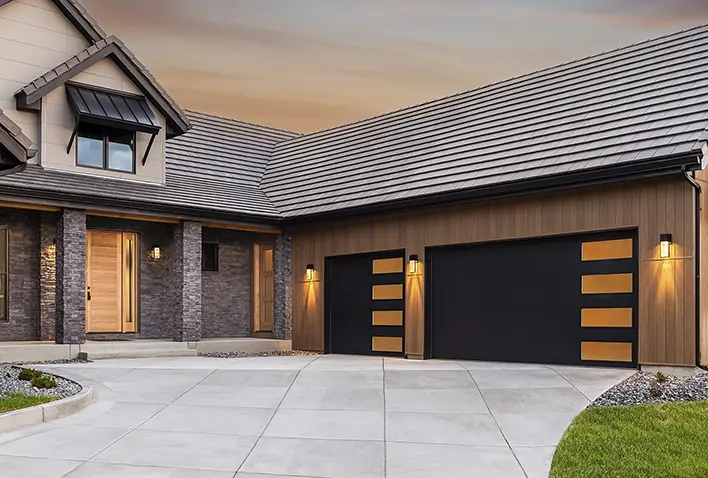
When planning a garage upgrade, new construction, or replacing an existing door, size is often one of the most critical—and sometimes overlooked—factors in the decision-making process. While it may seem like a straightforward measurement, the size of your garage door influences far more than just the appearance of your home’s exterior. It impacts vehicle clearance, storage options, insulation needs, hardware compatibility, and resale value. Choosing the right dimensions ensures your garage is functional for today and remains adaptable for future needs, such as larger vehicles or home additions. A precise understanding of garage door size leads to better design choices and long-term satisfaction.
Dimensions affect function, clearance, and future planning
- Standard Sizing and Why Variations Matter
Most residential garage doors come in standard widths of 8, 9, or 16 feet, with typical heights around 7 or 8 feet. However, these measurements aren’t one-size-fits-all. The size you need depends on whether you’re parking compact sedans, SUVs, trucks, or even recreational vehicles. For example, a single-car garage might suffice for a smaller car, but it could feel cramped with a larger SUV or if storage shelving is installed along the walls. Double-car garages, on the other hand, can vary significantly in width, and that variation matters when maneuvering wider vehicles or planning multiple points of entry. Adjusting the garage door height to accommodate taller vehicles is especially important for households with roof racks, vans, or utility trucks. Choosing slightly larger-than-average dimensions can provide flexibility and comfort, reducing the need for costly modifications when your vehicle needs change.
- Clearance and Interior Layout Considerations
Garage door size doesn’t just affect what can fit through the opening, but also influences how you utilize the space inside. Height and width impact how much room is available for overhead storage racks, ceiling-mounted equipment, or lighting placement. If your door is too low, it may obstruct shelving or hit ceiling fixtures during operation. Similarly, narrow doors can limit side clearance, making it challenging to install cabinets, charging stations for electric vehicles, or simply open car doors without bumping into walls. With growing interest in using garages as multi-purpose spaces—for gyms, workshops, or hobby areas—the door size must support those ambitions. Designing with these practical details in mind ensures your garage functions as more than just a parking space and adapts to evolving household needs without compromise or renovation.
- Visual Balance and Exterior Architecture
While functionality often takes center stage in garage planning, aesthetics are equally important. The size and proportions of the garage door play a major role in your home’s curb appeal. A door that’s too small for the structure can look awkward or dated, while an overly large door may overpower other design elements. Matching the door’s scale to the house’s architecture ensures harmony and a polished exterior appearance. It’s also essential to align the door with surrounding features such as windows, trim, and rooflines. A balanced layout contributes to a cohesive design and often enhances the property’s overall value. In neighborhoods with strict homeowners’ association rules or design guidelines, adhering to aesthetic standards while optimizing for practical garage door dimensions can balance compliance and custom comfort.
- Vehicle Trends and Long-Term Use
As vehicle designs evolve, so do the requirements for garage dimensions. In recent years, pickup trucks, SUVs, and electric vehicles with higher profiles or built-in charging gear have changed the baseline for a comfortable garage. A garage built in the 1980s or 1990s may not meet today’s needs without modifications. Forward-thinking homeowners consider their current car and potential future purchases when evaluating garage door size. A few extra inches in height or width could be the difference between needing to park in the driveway and comfortably using the garage for daily vehicle storage. Futureproofing your garage with this mindset is a strategic move that helps avoid costly retrofitting or layout adjustments. It’s also worth noting that taller and wider garage doors often improve ease of access for visiting family or guests who may drive different types of vehicles.
- Garage Door Openers and Size Compatibility
The dimensions of your garage door influence the type and power rating of the opener required for smooth and safe operation. Larger doors, particularly those with increased height or made from heavier materials like wood or insulated steel, may need a stronger motor and more robust support brackets. Standard openers may struggle with oversized doors, resulting in slower opening times or increased wear. This not only affects convenience but also has implications for long-term maintenance. Accounting for the door’s weight and movement during installation ensures your opener can handle the job efficiently. Door size influences sensor placement, safety clearance, and even the track system design. All these factors contribute to a well-functioning garage that doesn’t feel sluggish or unstable with daily use. Proper alignment of hardware and automation begins with sizing the door correctly from the start.
Choosing a Size That Works for You
Garage door size plays a significant role in your home’s daily function, safety, and aesthetics. From determining whether your SUV fits comfortably to deciding how to arrange overhead storage or where to install lighting, size matters in more ways than one. Considering current needs, future flexibility, visual appeal, and hardware requirements ensures your garage door works harmoniously with your lifestyle and property. Rather than sticking with outdated standards or making assumptions, assessing the right dimensions thoughtfully can lead to better long-term satisfaction. A well-sized garage door is not just a point of entry—it reflects how your home works for you today and how it will adapt to tomorrow.


